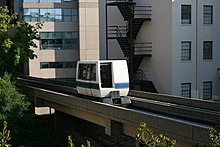Duke University Medical Center Patient Rapid Transit
| Personnel Rapid Transit | |
|---|---|
 | |
| Overview | |
| Locale | Durham, NC, US |
| Transit type | People mover |
| Number of stations | 3 |
| Operation | |
| Began operation | 1979-12-08 |
| Ended operation | 2009[verification needed] |
| Operator(s) | Duke University |
| Number of vehicles | 3 |
| Technical | |
| Track gauge | concrete guideway |
Duke University Medical Center Patient Rapid Transit or Personnel Rapid Transit (PRT) was an automated people mover system located at the Duke University Medical Center in North Carolina, in the United States.[1] The system was in operation from 1979 to 2009, and service is now discontinued.[2] The PRT was notable for having cars propelled by a linear induction motor and suspended on a bed of compressed air[3] similar to a hovercraft. Uniquely, the cars could move sideways, as well as backwards and forwards.[3]
The proclaimed "horizontal elevator" system was designed by Otis Elevator Company during the 1970s, installed beginning in 1977 and opened on December 8, 1979. The people mover was provided with three driverless Otis Hovair vehicles[4] which have a hinged-window at each end for emergency exit.[5]
The concrete guideway was built as double track, connecting the three stations at Duke South, Duke North and Parking Garage II via a tunnel under Erwin Road.[6]
Decommissioning
The 0.25-mile (<400 m) section between Duke South and Duke North was closed permanently on October 15, 2008 to allow for expansion of the hospital buildings.[2]
The remaining section connecting Duke Parking Garage II with Duke North Hospital was closed between late 2008 and early 2009. The doorway for the station at Parking Garage II was permanently boarded up and turned into a wall. The leftover tracks and infrastructure have since been largely removed to make way for new construction.
Technology
The Hovair technology has been installed around the world. Later variants have used the same air-cushion technology, but propelled the vehicles by wire cable, such as at the Getty Center in Los Angeles.[4]
References
- ^ "PRT Supervisor, Senior". Duke University Job Description. Duke University Human Resources. 2007-12-01. Retrieved 2009-10-17.
... Personnel Rapid Transit system utilized to transport patients, employees, visitors and supplies between Duke Hospital North, Duke Hospital South and Parking Garage II.
{{cite web}}:|archive-url=is malformed: timestamp (help) - ^ a b "Tram scrams Oct. 15". Inside Duke Medicine. 2008-09-01. Retrieved 2009-10-17.
in the 1970s when it was announced that a futuristic "horizontal elevator" would ferry ... between the Duke Hospital and its planned North Division. ... the inaugural ride on Dec. 8, 1979, ... Otis Elevator Co. had designed an innovative, pilotless shuttle that travels "on a cushion of air."
- ^ a b Wessner, Laura (December 1978). "Air-cusion people mover". Popular Science. 213 (No. 6). Bonnier Corporation: 64. ISSN 0161-7370.
three 22-passenger ... no rotating parts ... a linear-induction motor propels the cars ... ice, rain and snow don't limit performance ... the cars can move sideways
{{cite journal}}:|number=has extra text (help) - ^ a b Richards, Brian (2001). Horizontal elevators and peoplemovers. Taylor & Francis. p. 130. ISBN 978-0-415-26142-5. Retrieved 2009-10-17.
developed by Otis ... their first vehicle was called Hovair
{{cite book}}:|work=ignored (help) - ^ Peacock, Richard D. (Jan 1979). "Fire Safety Guidelines for Vehicles in a Downtown People Mover System" (NBSIR 78-1586). Washington: Center for Fire Research, National Engineering Laboratory, National Bureau of Standards.
{{cite journal}}: Cite journal requires|journal=(help) - ^ "Clinic Parking Information". Pediatric Urologic Care. Duke University Division of Urology. Retrieved 2009-10-17.
a walkway and monorail beneath Erwin Road from the garage to Duke Hospital

